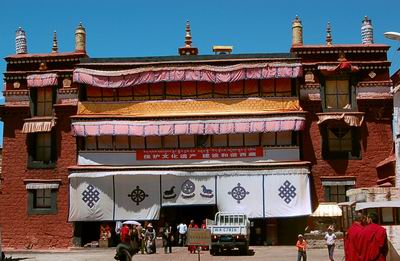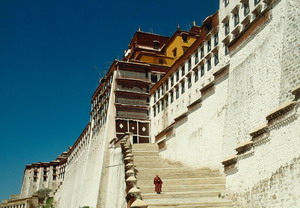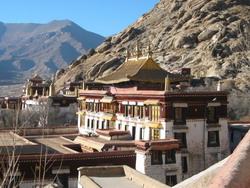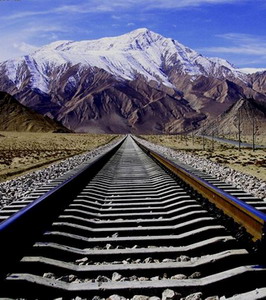| Day 11 Chengdu, Lhasa ( B ) |
| After breakfast, transferred to Chengdu airport for the morning flight to Lhasa. Be met at Lhasa airport by our English-speaking tour guide & transferred to your hotel. Free at leisure to acclimatize yourself to the high latituder. |
| Lhasa | Lhasa has an elevation of 3650 meters and sits at the center of the Tibet Plateau. It has a history of more than 1300 years. It towers as a huge magnet attracting those who want to explore its culture. Entry into Lhasa allows each traveler the chance to glimpse into Tibet. |
|
 |
| [ Optional ] Ramoche Monastery: it is one of the key cultural relic protection sites in Lhasa, located on the north of Barkhor Street, in the area with a local market and many traditional style Tibetan style civilian houses. |
|
| Day 12 Lhasa ( B,L ) |
| The rush hour of Potala Palace is 10am, so we highly recommend to register and
visit it in the early morning, otherwise you might only see the crowd. Plenty time
to stay around the Jokhang Monastery and the Barkhor Street in the afternoon. In
fact, if you visit the Ramoche Monastery nearby, you will find more local tea
houses, market and civilan houses. This is the local portion of Lhasa. |
| The Barkhor Street | The Barkhor Street is Lhasa's inner pilgrim circuit shaped roughly like an octagon that runs around the Jokhang. The circuit is lined with markets, shops, stalls and street vendors providing every conceivable item a Tibetan could need. The best place to start the circuit is right outside the Jokhan…… | | The Jokhang Temple | The Jokhang Temple is the spiritual centre of Tibet - a destination for millions of Tibetan pilgrims. The oldest part of the temple dates back to the 7th century AD - being one of the two temples built by King Songsten Gampo to house the statues of the Buddha that his two foreign wives brought to Ti…… | | The Potala Palace | The Potala Palace is a landmark of Lhasa and Lama Buddism. It is a 13 storey and 1000 rooms' palace and once winter residence of the Dalai Lama. The construction of the present structure began during the reign of the fifth Dalai Lama in 1645 and took more than 50 years to complete. |
|
 |
| [ Optional ] Tibetan Opera Performance: The Tibetan people are good at singing and dancing. Tibetan opera is called "Ajilamu" in Tibetan which means "sister fairy maiden". It is a kind of public square opera, which has play, vocal music, separate roles, accompanying band and special masks and clothes, and its main form is song and dance. |
|
| Day 13 Lhasa ( B,L ) |
| Visit the Tibet Museum and Sera, one of the most famous monasteries in Lhasa. A
visit to the local Tibetan family is a happy memory. Please prepare some gifts for
this family visit, such as candy or chocolate for kids. |
| The Tibet Museum | The Tibet Museum, located in the southeastern corner of Norbu Lingka, Lhasa, is the first of its kind in Tibet to be provided with the latest in equipment and facilities. The Tibet Museum was completed and opened in October 1999. | | Tibetan Family Visit | Every Tibetan family has been either directly or indirectly affected by the Chinese, Indian and Nepal culture. Family life is one of the most interesting attractions during your stay in Tibet. Common Tibetan people welcome you to their homes, greet you in their traditional way and entertain you with…… | | The Sera Monastery | The Sera Monastery lies on the northern edge of Lhasa at the base of Tatipu Hill. 'Sera' means 'merciful hail' denoting its rivalry with the 'Rice Heap' (Drepong) since hail destroys rice. Sera was smaller than Drepong with about 7,000 monks but was very rich and comparable in power. |
|
 |
| [ Optional ] Lhasa Carpet Factory: Lhasa Carpet Factory is a factory south of Yanhe Dong Lu near the University of Tibet in Lhasa the capital of Tibet. It produces traditional Tibetan rugs. The highland of Tibet is the actual home of the oriental carpets. By visiting Carpet Factory you will have a general idea of how carpets are produced. |
|
| Day 14 Lhasa ( B ) |
| After breakfast, transferred to Lhasa railway station for the morning train to Beijing. Train No.: T28 (08:30/07:34 next day's morning), takes 47 hours and 4 minutes. Stay overnight on the train. |
| Express train T28 Lhasa to Beijing | It departs from Lhasa at 09h20 on Day 1, arrives at Beijing West Train Station at 07h34 on Day 3. You need to stay 46 hours on the train. The train passes Xian at 20h22 on Day 2, many passengers end their train journey here, visit the Terra Cotta Warriors. |
|
 |
| [ Optional ] Qinghai-Tibet Railway: The highest point of the Qinghai-Tibet Railway is the Tanggula Mountain Pass, which is at an altitude more than 5,000 meters above sea level. At this point passengers may experience slight high-altitude-reaction symptoms, such as headaches, but they soon pass as the train heads downward. |
|
| Day 15 Lhasa ( ) |
| On the train. A good choice and opportunity to view the natural scenery and plateau landscape. It is said the landscape alongside the road is part of Tibet attractions. |
|
|
|
|